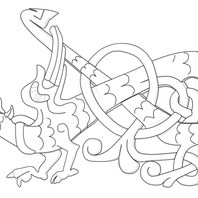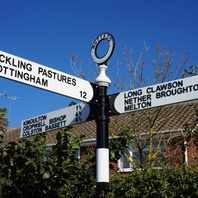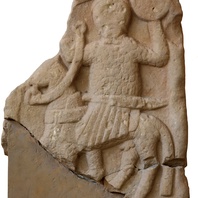
Viking Designs
Drawing of Detail from the Southwell Lintel
The lintel above a door in Southwell Minster features the Archangel Michael fighting off a Norse-style ribbon beast. This drawing shows a detail of the ribbon beast. The lintel is probably an eleventh-century grave cover that was recarved and decorated in the twelfth century and placed into a new position.
Read More

Viking Names
Hickling
Hickling, in the Bingham Wapentake of Nottinghamshire, has a name that was given probably quite early in Anglo-Saxon times in Old English. It is also recorded relatively early, first in a 14th-century copy of a document originally written around 1000. The -ing suffix indicates that the name refers to a group of people, who belonged to or were named after a person called Hicel(a). It is therefore not a Viking name. However, it is included here because St Luke’s Church in Hickling is the location of an early medieval grave-cover that is often regarded as a ‘hogback’ a type of Anglo-Scandinavian monument generally found further north (indeed this would be the most southerly example). It is quite common for sculpture with Scandinavian features or showing Scandinavian influence to be found in villages with English names, and this applies to other forms of material culture too. There is therefore no automatic connection between the name of a place and other evidence for Scandinavian influence, and this raises many interesting questions about the processes of acculturation, integration and diaspora that resulted from the Viking invasions.
Read More

Viking Objects
Repton Stone (1989-59/1165)
The Repton Stone, as it is now known, was found in a pit near the eastern window of the Church of St Wystan, Repton, Derbyshire in 1979. It was originally carved on all four faces, but recognisable detail remains only on two of them. The Repton Stone is a section of a sandstone cross shaft carved on one side with a mounted armed figure (Face A), on the other with a monstrous creature eating the heads of two people (Face B). It was broken Face A: A moustachioed armed figure on horseback with sword and shield raised in the air is carved on this face. The horse is very clearly a stallion. Incised decoration, where the design is scratched into the surface, shows that the rider was depicted wearing armour and carrying a second weapon at his waist, perhaps a seax (knife or dagger). The armour was probably intended to be mail although the carving suggests scale. The mounted man appears to be wearing a diadem, suggesting that he was of high rank. He is wearing a pleated tunic under his armour, and has cross-gartered legs. The reins of the horse are looped over his right arm. Elements of the tack are clearly visible. Face B: This face would have been on the side of the cross. The monstrous creature on this face consists of a snake-like body with the face of a human being. The serpent beast appears to be devouring the heads of the two human figures that embrace in front of it. The serpent may be a representation of the Hellmouth devouring souls. The pit the stone was found in probably dates to the eleventh century or early twelfth century. However, the cross was probably much earlier in date, being broken up close to the time it was deposited in the pit. It is probable that the cross was made before the Viking camp in 873/4 because the monastery that stood on this site before the Vikings was not refounded after the Vikings adopted Christianity. The presence of this cross at the site of a Viking camp shows that Repton was an important place before the Vikings made it their temporary abode. This may have been one reason that the Vikings chose Repton for one of their camps, although its proximity to the River Trent would also have been an important factor. The Vikings used waterways to access the interior of the country, so it is not surprising to find their winter camps beside navigable rivers.
